Rifles, loads and the task at hand define “good accuracy.” Only the shooter can put it to work!
When the fourth bullet egged the hole, I winced. The fifth made it a long egg. Still, that .28-inch group pleased me. I’d fired it with a borrowed rifle in 6mm Creedmoor – a hunting rifle – over a hastily adjusted rest. Hunting, I’m often packing rifles that on good days won’t consistently shoot into an inch.
On the other hand, .28 for five bullets at 100 yards would rank as mediocre in many Benchrest matches. And not long ago an 83-year-old ace kept 10 shots inside 2.7 inches at 1,000 yards!

Bench Rest competition dates to the 1940s, first at 100 and 200 yards, now with targets as far as 1,000
The path to such high standards winds back to muzzle-loading days.
In the mid-19th century, shooters firing rifles from benches weren’t competing; they were testing fresh developments in rifling, barrels and bullets. Ponderous black-powder rifles designed to punch little knots in friendly shoots evolved. In 1859 the National Rifle Club, formed a year earlier in Framingham, Massachusetts, held a match at 40 rods (220 feet). Scoring was done by string measure. That is, pegs were inserted after a relay (commonly 10 shots). A string anchored in the target’s center was looped about each and brought back to center. After 50 shots, the winner’s string measured just 54 inches! In other words, the bullets struck an average of 1.08 inches from center! Arguably, this out-dated way to gauge accuracy is more instructive than simply measuring a group’s greatest spread, often exaggerated by one wild shot.
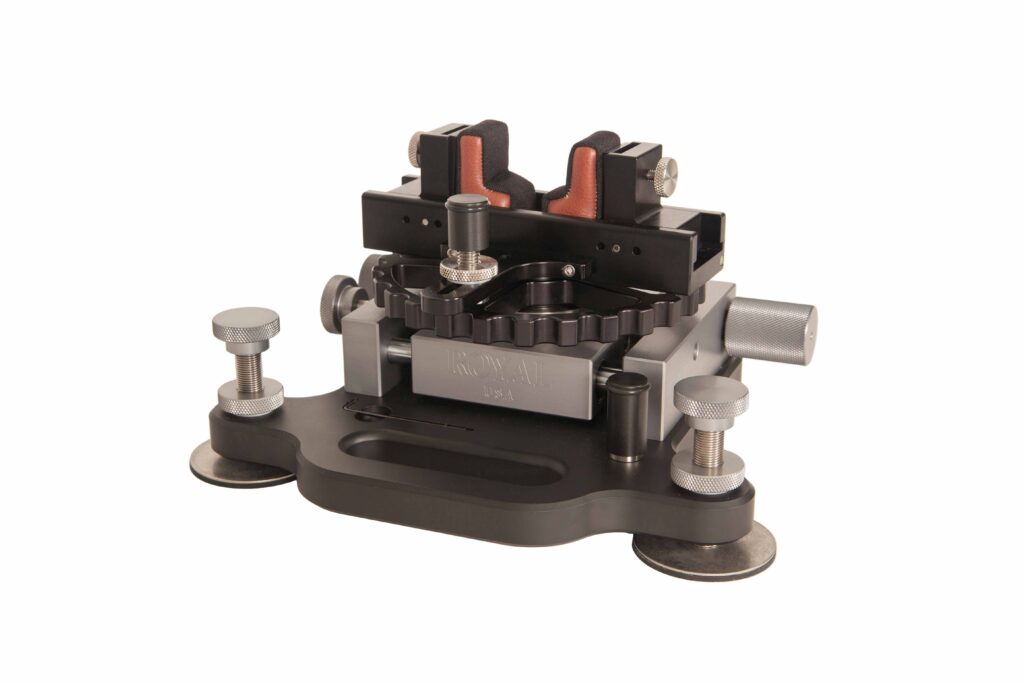
Royal Stukey’s is a rest worthy of top competitive shooters. Bench Rest is a gear-heavy game!
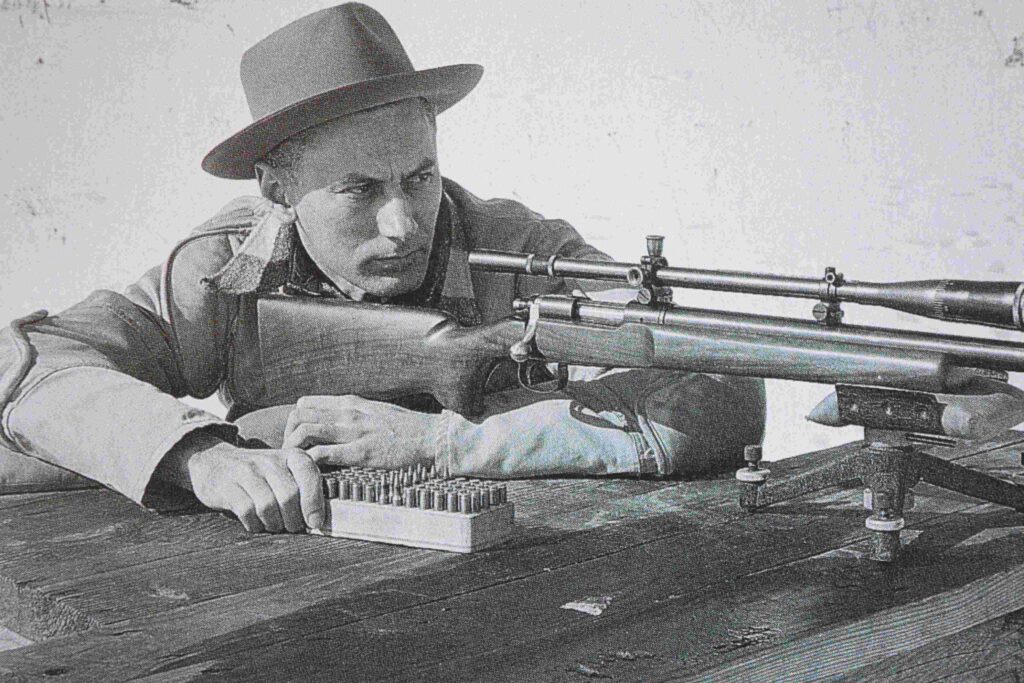
Bench Rest shooter Mike Walker designed Remington’s Model 722 rifle. It arrived with the 721 in ‘48
During the Civil War skilled marksmen with heavy, scoped rifles threatened troops at great range. Colonel Hiram Berdan impressed would-be recruits with a 32-pound .48-bore percussion rifle and a “Jeff Davis” target. From 200 yards, he reportedly shot out the eyes and vest buttons at will. To qualify for his regiment, applicants had to put 10 consecutive shot within an average 5 inches of center at that distance.
Muzzle-loading bullets heavier than the hollow-base Minie of that day were brought up to groove diameter by a paper wrap the length of the shank. The tail was twisted to keep it in place. As with linen, lubrication helped the wrap adhere and cleaned the bore during seating. Competitors used paper-patched bullets in the famous 1874 match fired at 800, 900 and 1,000 yards on the just-opened Creedmoor venue on Long Island, where an untrained U.S. team challenged the Irish champs. The Sharps Rifle Company’s new Model 1874 Creedmoor long-range rifle fired a 500-grain 44-caliber bullet from a bottle-neck case loaded with 75 grains of Fg black powder. Remington fielded a similar rifle on its Rolling Block action. The Irish, firing muzzle-loading Rigbys, were narrowly beaten.

This lightweight long-range rifle is ready for trials in a Stukey rest on a Stukey bench. Solid support!
Paper-patched bullets endured into the cartridge era. Shooters obsessed with accuracy in the late 1800s tested their skills and breech-loading single-shot rifles at 200 yards from a bench, or offhand in the German “Scheutzen” game. Ace barrel-maker Harry Pope installed a false muzzle so the bullet could be loaded from the front while a charged case was inserted at the breech. This method ensured against tiny nicks on the bullet’s base, which might affect accuracy. Some shooters reloaded a single case for all their shots, de-capping and re-priming it after every discharge, the adding powder, secured with blotting paper.

The National Match Course is fired with iron sights to 600 yards (here) and without artificial support.
Perhaps the best-known group of that day was fired by C.W. Rowland in Boulder, Colorado, May 16, 1901. Using Hazard’s Fg powder in a .32-40 Pope-barreled Ballard rifle, and aiming through a 20x Stevens scope over a Pope machine rest, Rowland put 10 bullets through one ragged .725-inch hole at 200 yards! Few modern hunting rifles with jacketed bullets and the best optics can upstage that performance!

A handload in 6mm BR drilled this cloverleaf from a Parkwest rifle (formerly Nesika, by Dakota)

This accurate Nesika in .20 Tactical has almost no recoil. Result: no flinch, bench groups under .3 inch
In the 1890s, new “fluid steel” brooked the higher pressures of smokeless powder. WW I turned shooters’ focus from single-shots and lever rifles to bolt-actions. In the Northeast during the ‘20s and ‘30s target shooters and woodchuck hunters of experimental bent followed Charles Newton’s .250 Savage with cartridges like the 2R Lovell, .219 Donaldson Wasp, .257 Roberts and .22-250. After WW II, shooters on both coasts were nipping tight groups with smallbore bolt rifles. A match at the Pine Tree Rifle Club of Johnstown, New York in 1947 is broadly acknowledged as the start of modern Bench Rest shooting. The National Bench Rest Shooters Association emerged to make rules, help local groups conduct matches and keep records. In 1970 a group broke from NBRSA to form the International Benchrest Shooters. Both are still active. The first world championships happened in France in 1989.
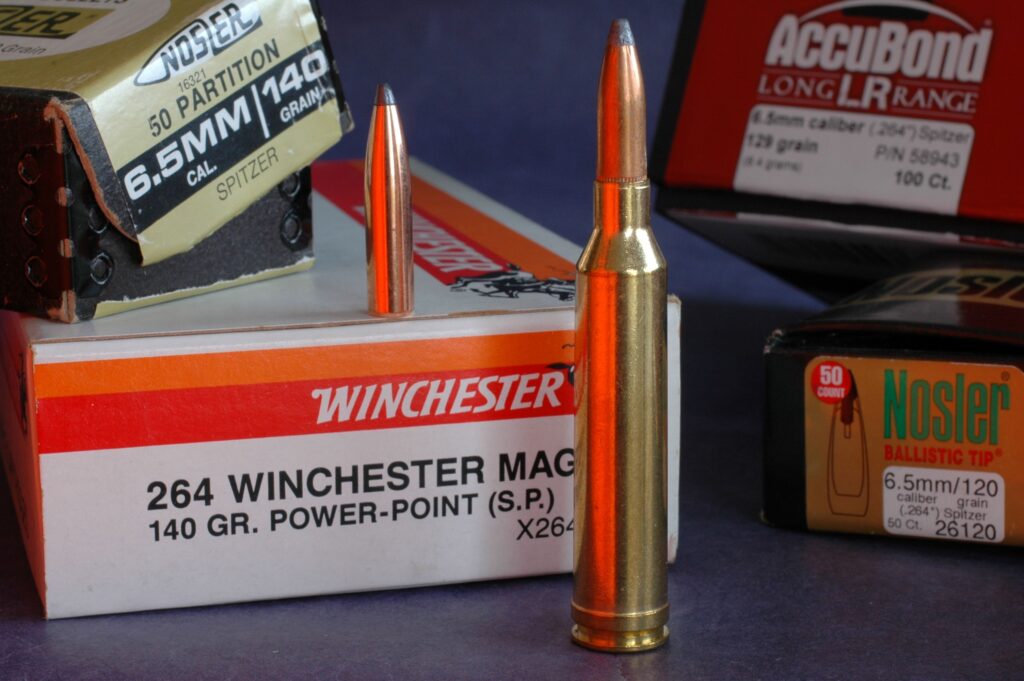
Handloaded, the .264 can shoot faster, more accurately than with factory ammo little changed in years
Initially fired at 100 and 200 yards, Bench Rest matches soon stretched to 1,000. In 1970, Mary Louise DeVito fired 168-grain Sierra MatchKings from a 7mm/.300 Weatherby to set a world record with a 1,000-yard group spanning less than 8 inches. But competition was just heating up! At a 2007 Ohio IBS event, Tom Sarver drilled an incredible 1.403 inch group with 240-grain MatchKings from his .300 Hulk (a shortened, necked .338 Lapua). As amazing: He fired it in Light Gun competition, and put every pullet in the X-ring, to score a record 50-5x!

Is the .270 inherently accurate? Wayne’s Bergara shoots well with several loads. This one’s a champ!
But wait! On February 10, 2021, at the Saguaro 1,000-yard NBRSA match, Charles Greer held to his habit of breaking records by setting two new ones with a single 10-shot string from his Heavy Gun in .300 WSM. The Tucson Rifle Club’s host range is known for frisky wind, so after firing his five sighting shots to confirm conditions, the 83-year-old sharpshooter “dumped” his record string quickly, to beat any change in the steady breeze. All the 220-grain Berger Long Range Hybrid Target bullets from his Krieger barrel had drilled the X-ring, for the first perfect 10-shot 1,000-yard score in registered competition! Its 2.657 span trumped the previous 3.650-inch record for group size, posted in 2019.
Few hunters expect one-hole accuracy from their rifles. Few hunting rifles deliver it. But even if yours does, you can still miss vitals at spitball range. I have. The inherent accuracy of a rifle and its load matters no more than the price of tea in Taipei if you don’t control the rifle as the trigger breaks.

Beat this group with handloads from Marlin’s lever rifle? Unlikely! Some factory ammo is very good!
Hunters who lift their rifles from the bench or bipod find the crosswire gets lively. Prone, with a taut sling, you can limit its motion to the bump of your pulse. From sitting and kneeling, that reticle gets restless. Offhand, it bounces violently. Riflemen who put their ego on the line avoid firing from hunting positions at paper targets. Holes reveal the bald truth that killing shots on game hardly ever hinge on the intrinsic accuracy of rifles or loads.
Distance exaggerates error. A rifle that prints 1 ½-inch groups from the bench should shoot into 3 inches at 200, 4 ½ inches at 300, 6 inches at 400. Sometimes the measure in minutes of angle shrinks a bit with increasing range, as bullets “settle down.” But that’s a tale for another day. To sum, at 400 yards even 1 ½-minute accuracy keeps bullets within 3 inches of point of aim – well inside the chest of a small deer. And 400 yards is twice as far as most big game is shot!
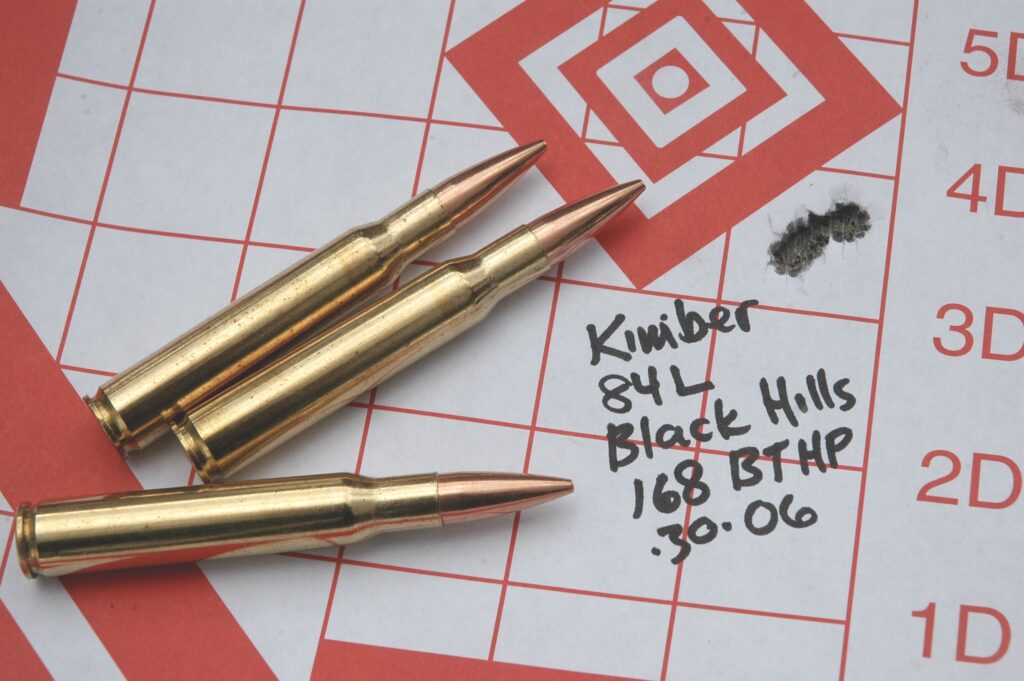
This Black Hills load made a lightweight Kimber 84L perform like a match rifle, beating handloads.
Alas, in human hands, a rifle is never still. It bounces constantly to your pulse. Muscles tire and twitch. Joints slip and roll, as designed. Even without breathing, which adds ocean-swells of motion, you can’t keep a rifle from jerking about like a child’s scribble in space. From sitting or kneeling – or standing with the rifle pressed against a tree – the reticle can sweep an entire rib-cage at 200 yards, and well off a deer at 300. That’s as far as I’ll fire at game from a sit, even with a taut sling. Offhand without support, I’m loath to send bullets over 150 yards.
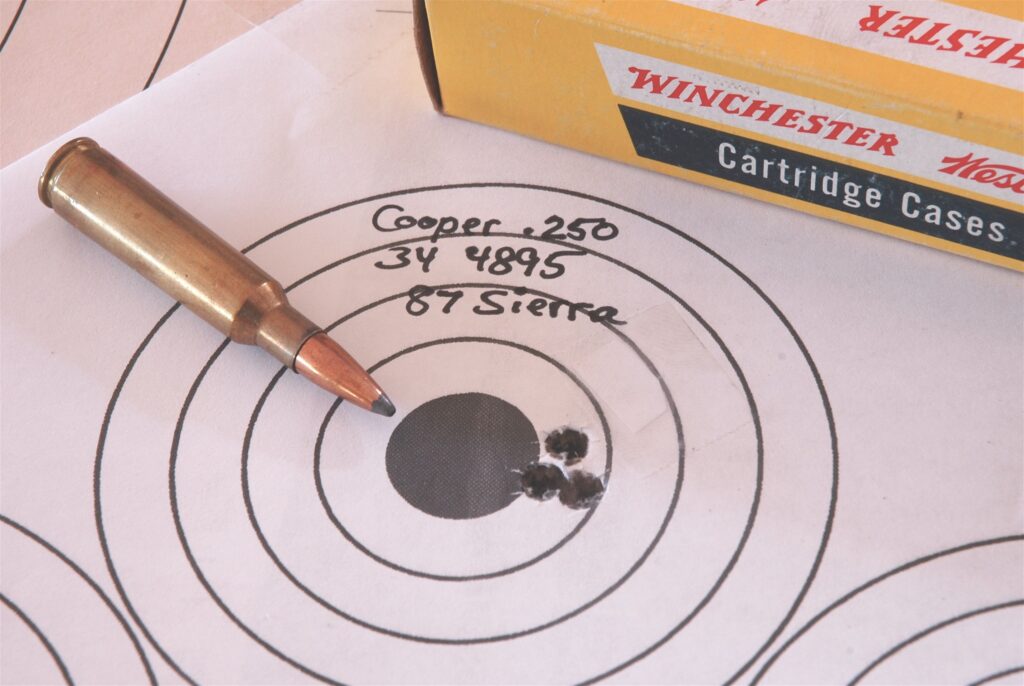
Factory .250 Savage ammo disappointed Wayne in an accurate Cooper rifle. His handloads excelled.
If your pulse is racing or you’re gulping air after a climb or fighting stiff wind, error multiplies.
I’ve heard hunters claim they can shoot more accurately at game than at paper targets. I’ve yet to see anyone do that. Targets don’t leave you breathless. They don’t move or use brush to block your view. They don’t impose a time limit on your shot. They seldom stay so you can fire again.
Recoil shouldn’t affect field accuracy; after all, it follows the shot. But anticipation of recoil can prompt a flinch. It’s as natural as a blink when you bring your own hand swiftly toward your eye! You know the hand won’t touch you, or the rifle hurt you, but these reactions are hard-wired. A muzzle brake reduces recoil; but anticipation of the increased can also trigger a flinch.
If intrinsic accuracy matters so little in a hunting rifle, why do manufacturers promise 1-inch or even half-inch groups at 100 yards? Well, accuracy has long been a measure of quality in a rifle. Beyond safe, reliable function, it’s the only performance that can be “ironed in” at the factory. What ensues when an elk appears in the scope depends on you: Did you zero the rifle properly, aim as conditions urged and execute the shot well – or decline because you really didn’t have a sure shot at the beast? The rifle-maker has no control over the bullet you choose, or how you handload.

From field positions, the accuracy of rifle and load matters little. The shooter determines the results
Once, over a portable rest, I checked the accuracy of 74 loads in popular hunting cartridges, from .243 Winchester to .338 Winchester Magnum. The rifles were un-tuned commercial sporters. The average extreme spread of three-shot groups came in at 1.7 inches, the average of five-shot groups at 2.1 inches. By some standards, that’s not impressive; but neither is it what you must accept.
Testing several factory loads, you may find your rifle favors one. In my trials, a Winchester M70 .270 that printed 1.3- and 1.7-inch groups drilled .6-inch groups with two other loads. A Remington M700 in .338 almost earned a “for sale” tag with a 3.6-inch group – but shot the next load into an inch.

The tools and task define “good accuracy.” Here: results from Wayne’s iron-sighted 03A3 Springfield
Of course, handloading multiplies your options. There’s not much selection these days in factory ammo for the .250 Savage. And most of it was developed years ago. I found none that shot well from my bolt-action Cooper. I handloaded 87-grain Sierras to standard velocities and poke a .55-inch delta!
But I find little point in handloading for a new Marlin .45-70 that cut one hole with Hornady FTX bullets in LeverEvolution factory loads. In my youth, such accuracy was unheard-of from “deer rifles!”
However you seek better accuracy, Midsouth Shooters Supply can furnish tools and components to help you find it!
Sidebar: Accurate cartridges?
Some cartridges hailed as “intrinsically accurate” show superior case design; others are blessed with big selections of factory loads – including “match” offerings – developed in various rifling types and throats. Older rounds that lack such attention sometimes shine when given a different bore. My first 7×57 rifle shot poorly. I found the throat was so long, I couldn’t touch the lands with the heaviest bullets seated so case rims barely clutched their heels! Another rifle restored my faith in the 7×57. Rifle-maker D’Arcy Echols likes that round, also the .308, .30-06, .300 H&H, .300 Winchester, .375 H&H, even the .458 Lott. He’ll add the .300 Weatherby to that “accurate” list if he can cut the chamber with a short throat. The .280 Remington and Winchester’s .338 seem, he says, “temperamental.” He doesn’t predict long-range results from short-range tests: “One .300 Weatherby averaged .6 for three shots at 100 yards. But it also averaged .6 at 200 and has shot into an inch at 300! I guess bullets from that rifle just stabilized farther out.”








